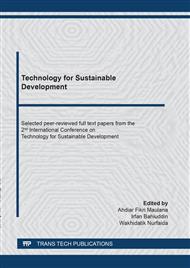[1]
Ratnaningtyas, D.D., & Surendro, K. (2013). Information Quality Improvement Model on Hospital Information System using Six Sigma. Procedia Technology, 9, 1166-1172.
DOI: 10.1016/j.protcy.2013.12.130
Google Scholar
[2]
Ludwick, D.A., & Doucette, J. (2009). Adopting Electronic Medical Records in Primary, Lesson Learned from Health Information System Implementation Experience in Seven Countries. International Journal of Biomedical Informatics, 22-31.
DOI: 10.1016/j.ijmedinf.2008.06.005
Google Scholar
[3]
Jahanbakhsh, M., Tavakoli, N., & Mokhtari, H. (2011). Challenges of EHR implementation and related guidelines in Isfahan. Procedia Computer Science, 3, 1199-1204.
DOI: 10.1016/j.procs.2010.12.194
Google Scholar
[4]
Wade, M., Obwegeser, N. (2019). How to Choose the Right Digital Leader for Your Company. MIT Sloan Management Review, 60, 1-4.
Google Scholar
[5]
Weber, P.S., Weber, J.E. (2001). Changes in employee perceptions during organizational change. Journals Leadership & Organization Development Journal, 22(6).
DOI: 10.1108/01437730110403222
Google Scholar
[6]
Shoolin, JS. Change Management Recommendations for Successful Electronic Medical Records. (2010). Applied Clinical Informatics, 1(3), 286-292.
DOI: 10.4338/aci-2010-01-r-0001
Google Scholar
[7]
Gagnon M. P., Desmartis, M., Labrecque, M., L_gar_, F., Lamothe, L., Fortin, J., Rancourt, J., Duplantie, J. (2010). Implementation of an electronic medical record in family practice: a case study. Journal of Innovation in Health Informatics, 18(1).
DOI: 10.14236/jhi.v18i1.751
Google Scholar
[8]
Jetwab, R.M., Hutchinson, A.M., Manias, E., Calvo, R.A., Dobroff, N., Glozier, N., Redley, B. (2021). Nurse Motivation, Engagement and Well-Being before an Electronic Medical Record System Implementation: A Mixed Methods Study. International Journal of Environmental Research dan Public Health, 18(5).
DOI: 10.3390/ijerph18052726
Google Scholar
[9]
Martinez, F. (2019). Process excellence the key for digitalization. Business Process Management Journal, 25(7).
Google Scholar
[10]
Wang, S.J., Middleton, B., Prosser, S. A., Bardon, C. G., Spurr, Carchidi, P.J., Kittler, A. F., Goldszer, R.C., Fairchild, D. G., Sussman, A. J., Kuperman, G. J., Bates, D. W. (2003). A cost-benefit analysis of electronic medical records in primary care. The American Journal of Medicine, 114(5), 397-403.
DOI: 10.1016/s0002-9343(03)00057-3
Google Scholar
[11]
Ghazisaeidi M., Ahmadi M. (2013). Sadoughi F. An assesment of Readiness for Pre Implementation of Electronic Health Record in Iran: a Practical Approach to Implementation in general and Teaching Hospitals. Acta Med Iran, 52(7), 533-544.
Google Scholar
[12]
Kukafka, R., Ancker, J. S., Chan, C., Chelico, J., Khan, S., Mortoti, S., Natarajan, K., Presley, K., Stephens, K. (2007). Redesigning electronic health record systems to support public health. Journal of Biomedical Informatics, 40(4), 398-409.
DOI: 10.1016/j.jbi.2007.07.001
Google Scholar
[13]
Aaronson, J., Murphy-Cullen, C. L., Chop, W. M., & Frey, R. D. (2001). Electronic Medical Records: The Family Practice Resident Perspective. Medical Informatics, 128-132.
Google Scholar
[14]
Silow-Carroll, S., Edwards, J.N., & Rodin, D. (2012). Using electronic health records to improve quality and efficiency: the experiences of leading hospitals. Issue Brief (Commonw Fund), 17(1), 40.
Google Scholar
[15]
Smelcer JB, Jacobs HM, Kantrovich L. Usability of Electronic Medical Records. (2009). J Usability Stud, 4(2), 70-84.
Google Scholar
[16]
Pizziferri, L., Kittler, A. F., Volk, L. A., Honour, M. M., Gupta, S., Wang, S. (2005). Primary Care Physician Time Utilization Before and After Implementation of An Electronic Health Record: A Time-Motion Study. Journal of Biomedical Informatics, 38, 176-188.
DOI: 10.1016/j.jbi.2004.11.009
Google Scholar
[17]
Odekunle, F. F., Odekunle, R. O., Shankar, S. (2017). Why sub-Saharan Africa lags in electronic health record adoption and possible strategies to increase its adoption in this region. International Journal of Health Sciences, 11(4), 59-64.
Google Scholar


